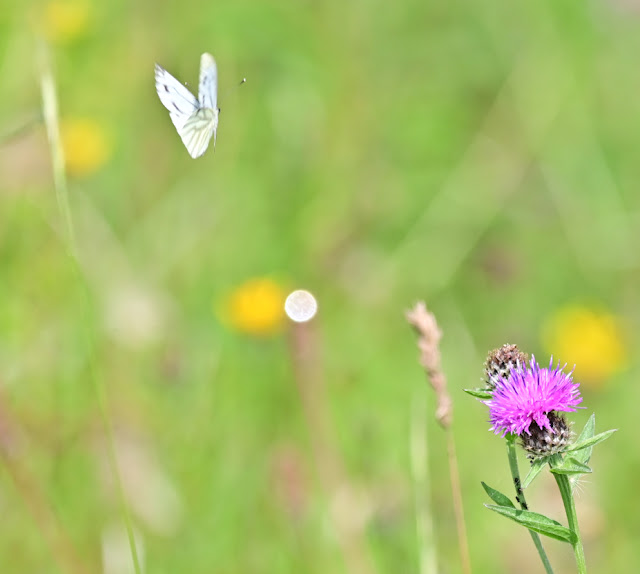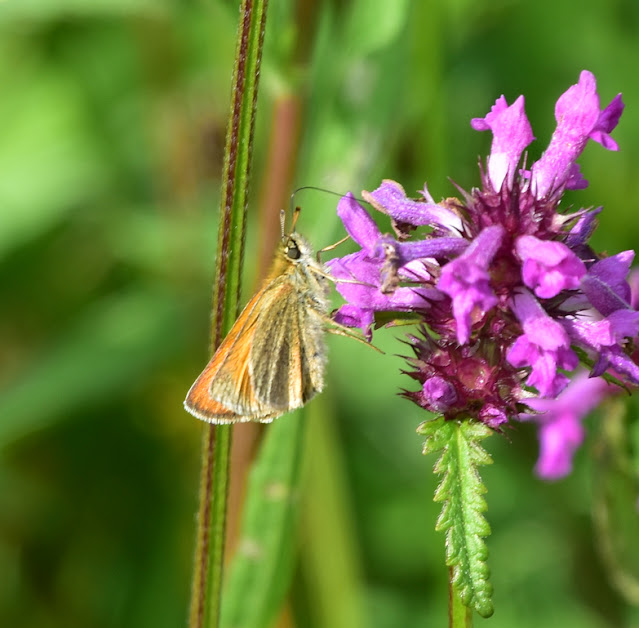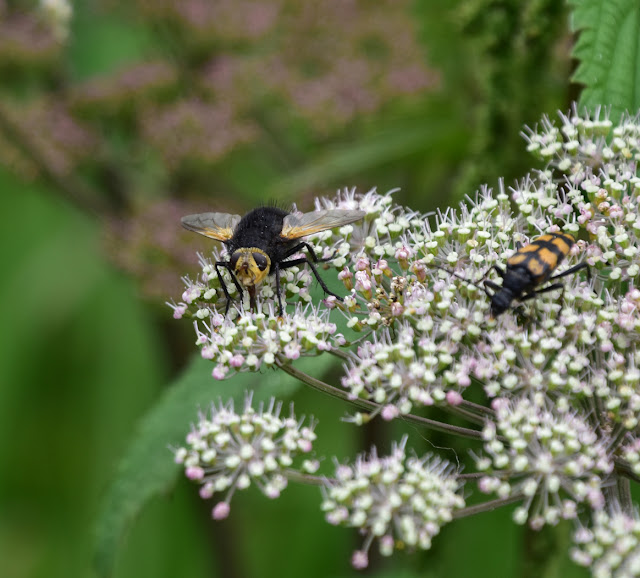The Safari was once again kindly taken on an outing by CR and as usual we met up with IH this time at the Cumbria Wildlife Trust's Foulshaw Moss reserve. We had little intention of deliberately looking for their very distant Ospreys but should one (or more) fly over us we would certainly look up. Our main targets were things with scales and insects. There was a chance of Lesser Redpoll (aka just Redpoll now they've all been lumped) on the feeders. When we pulled up in the car park the feeders were busy with several species of birds but not the one we wanted! A couple of Siskins were pick of the bunch.
At the little hide along the trail we met a family of very keen youngsters also out looking for lizards but not quite so enthusiastic about the prespect of seeing any snakes. They pointed out a young
Great Spotted Woodpecker and told us there'd been two. They left to find their lizards while we stayed a few more minuted witing to see if any
Redpolls appeared - they didn't so we set off along the trail too and soon finding a fresh
Large Skipper.
The boardwalk was fairly busy with naturalists peering here and there with bins and cameras which didn't bode well for catching a glimpse of any snakes using the boardwalk to bask as they often do. We did spot our first
Common Lizard of the day though.
It was then that IH pointed out a small bird high on a snag. The light wasn't brilliant looking through the bins and between us we thought either a pipit or maybe a
Spotted Flycatcher, the later being the most favoured due to its short, chuncky bill and very upright stance. We need
Spotted Flycatcher for our Challenge so lifted thecamera and....nothing! eh??? Turn the darned thing on as soon as you leave the car!!! WE flipped the ON switch swung the camera back towards the dead snag only to hear IH saying its gone over our heads that way, pointing to a dot heading towards a copse of trees in the distance - dohhhhh!!!!! With all the activity ahead of us we decided to about turn and do the other much less used boardwalk which we hoped would be quieter - it was and we could slowly creep along it looking in all the spots the sun was catching - not many! - to see if any
Adders were basking. All the while checking the boardwalk ahead of us for the same and any more
Common Lizards of which there were several. The dull conditions were having a negative affect on the invertebrates too as we were seeing very few dragonflies and not many damselflies. Eventually an
Azure Damselfly alighted in a gettable spot.
A grasshopper hopped onto the boardwalk in front of us, a check of the pic once dowloaded back at Base camp suggests it's a
Mottled Grasshopper, a new species for us.
A little further along the trail there's a good spot to check out for reptiles so we did and found some
Slow Worms and a
Common Toad, obviously not a reptile.
retracing our steps we caught up with the family again, they were having a bit of 'baggin' on the bench overlooking the 'new'
Osprey nest, one to watch next year, it's much closer than the original one. Next to them was a
Hogweed flowerhead buzzing with insects. CR picked out a striking
4-banded Longhorn Beetleand an weird
Tachina grossa fly
Weird as these invertebrates are they weren't lizards so the kids sort of poo-hooed them. We left them to their snacks and continued on our merry way looking for all manner of buzzing, flitting and slithering things. Top of the pops was this
Green Veined White.At the road we opted to go anti-clockwise round the main boardwalk passing several more
Common Lizards and unphotographable
Redpolls as we walked on. A naturalist commong the otherr way told us he'd not long since seen an
Adder but when we reached the spot he described there was no sign of it, by now the sun was out and snakes and stuff would have warmed up and been mobile rather than basking to gain heat. We continued our quest for all things invertebrate which became rather productive.
 |
Female Black Darter
|
 |
Meadow Grasshopper
|
 |
Male Black Darter
|
 |
A better female Black Darter
|
 |
Juvenile Common Lizard
|
 |
Great Bog Hoverfly Sericomyia silentis
|
Soon we were back near the
Spotted Flycatcher tree and there was a bird sat up there again. Bingo! We were still a fair way off but just in case of another flit we fired off some shots and then moved a few yards closer, repeating the porocess several times. But it wasn't the Spotted Flycatcher back on a favoured perch it was a
Redpoll. #157 for the Challenge but we've surely missed the chance of a
Spotted Flycatcher now. Just eight more species to photograph this year within 75 miles of base camp to reach our taget of 165.
After completing the round of the site and still too early for lunch we moved a mile up the road to another mossland reserve Meathop Moss. We had this site all to ourselves and mooched slowly along the boardwalk scanning left and right and, of course, along the boardwalk in front of us in case of basking lizards and snakes.
Green Veined Whites were one of the 'Butterflies of the Day', almost every white butterfly we were able to identify turned out to be one of them.
And, like at Foulshaw, there were plenty of
Common Lizards darting off the edge of the woodwork as we approache, few of them staying still long enough for a pic.

It's not a long trail and covers only a tiny fraction of what is quite a large reserve so we soon reched the 'outer' portion. It was here were were treated to a triple whammy
Raven/Osprey fly past with three of each in the air together. Two of the
Ospreys landed together in a dead tree close to their nest. It's a lot closer than the Foulshaw nest but still a long way off.
Closer to hand were lots of
Round Leaved Sundew plants
In scattered places on the boggy
Sphangnum Moss there were several tiny little red berries. We've no idea what they might be but you can see how small they are compared to the nearby
Sundew. They do seem to have a little stalk but there's no overhead trees or shrubs they can have fallen from. Anyone any ideas?
There were still very few dragonflies on the wing despite the warming conditions. This male Common Darter was one of the few coloured-up ones we saw all day.
Here's a view across the moss showing the pink of the Cross Leaved Heath flowers and the unknown white flowers of a sedge-like thingy.
which on closer inspection the useful but not to be totally relied upon Obsidentify app did its thing and identified it as
White Beaked Sedge.
While creeping around on all fours trying to get a good look at the
White Beaked Sedge we spotted that some of the
Sundews had tiny white flowers close by. Do Sundews have flowers? We gently tugged at one and yes it was attached to the rest of the plant - well we never knew that!.
The boardwalk offered up a couple more photo ops with a nicely coloured
Common Lizardand a female
Meadow Grasshopper.
Some
Osprey yikkering above us made us look up, two
Ospreys were circling around high up away to our right. After a few minutes they drifted apart, one being lost in the distance the other coming right overhead.

Now the boardwalk enters a bit of a wooded area where ew managed to disturb a
Brimstone from a path-edge shrub. It fluttered around for a while before landing back in dappled cover where it became almost but not quite invisible and thence our third species of butterfly photographed during the morning.
Another step forward brought us to a bright patch of sunlight where a female
Black Darter was perched up, her wings catching the sunlight in a spangle of irridescent shimmer as she was blown about on her mobile perch in the breeze.
Now it was well past butty time, rather than eat here we moved anothere mile to the other side of the main road to Latterbarrow reserve. We ate our pies and butties at the bench while IH almost became lunch for this attractive but nasty biter, a
Splayed Deerfly.
Meanwhile we weren't sure if a female
Kestrel that swooped in close by had eyes on our pies or not.
Not was the answer, she swooped down on an unfortunate vole and flew off with it out of sight.
The insects didn't disappoint either.
 |
6-spot Burnet Moth on Black Knapweed
|
 |
Field Grasshopper
|
 |
Female Common Darter
|
 |
One of the very many Silver Y moths
|
 |
Another Field Grasshopper
|
 |
Mating Black and Yellow Longhorn Beetles
|
 |
A tiny wasp with a big ovipositor
|
 |
Black and Yellow Longhorn Beetle
|
 |
| Another female Common Darter |
 |
6-spot Burnet Moth and a bumblebee on Field Scabious
|
Something we've not seen for a few years now and did occur on our former very biodiverse Patch 1 which sadly is now being developed as yet another housing estate, how they can justify or acieve 'No net loss of biodiversity' we don't know!, anyway it's half plant half insect, the Pincushion Gall aka Robin's Pinchushion. The reaction of the host palnt Dog Rose to infection by parthenognic females of the tiny gall-wasp Diplolepis rosae.































































No comments:
Post a Comment